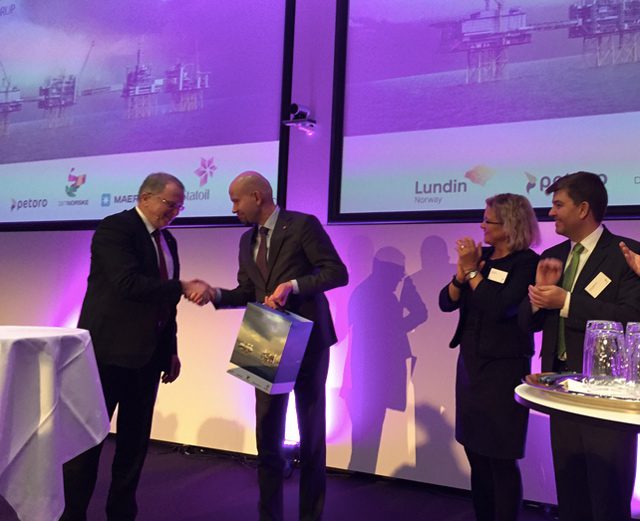Minister of Petroleum and Energy, Tord Lien, receives the plan for development and operation for Johan Sverdrup, image: Det Norske
By Mikael Holter
(Bloomberg) — Owners of Norway’s biggest oil find in decades, including Statoil ASA and Det Norske Oljeselskap ASA, failed to agree on how to divide the $177 billion in projected income, forcing the government to decide on the stakes.
Det Norske, controlled by billionaire Kjell Inge Roekke, said it opposed a split approved by its four partners because it didn’t fully reflect that barrels on its side of the field are more valuable. The majority of the owners said they would now leave it up to the Petroleum and Energy Ministry to decide.
“What’s on the table today is too little,” Sverre Skogen, chairman of Det Norske, said in an interview. “We need to stand up for everyone who works at Det Norske, its board and its shareholders.”
The companies, which also include Lundin Petroleum AB, still presented a plan for development and operation to the government today, keeping the project on shedule. Sverdrup is seen as key to keeping Norway’s oil industry afloat as plunging oil prices force explorers and producers to cut spending.
Investments for the first phase, due to start in late 2019, are estimated at 117 billion kroner ($15 billion), in line with an earlier estimate of 110 billion to 120 billion kroner, Statoil said. Recoverable resources are seen at 1.7 billion to 3 billion barrels of oil equivalent, a wider estimate than earlier.
Shares Climb
Det Norske rose 4.2 percent to 38.5 kroner as of 1:57 p.m. in Oslo. Statoil climbed 3 percent. Lundin rose 1.4 percent in Stockholm, while another partner, A.P. Moeller-Maersk A/S, gained 2.1 percent.
The fissures were revealed yesterday after Det Norske made its objections clear by posting a statement and a video, saying the talks were in a “critical” phase. The field covers three licenses that include a range of reservoir qualities.
Stakes are high for Det Norske and Lundin, which are the smallest companies of the license owners. Det Norske, which spent $2.7 billion last year on expanding its production, may run out of funding before Sverdrup’s production start, Chief Executive Officer Karl Johnny Hersvik said today.
Statoil’s proposal, which the government will now decide on, allocates 40.0267 percent to Statoil, 22.12 percent to Lundin, 17.84 percent to state-run Petoro AS, 11.8933 percent to Det Norske and 8.12 percent to Maersk. The majority’s proposal for the allocation of resources is valid until the ministry decides, Statoil said.
‘Good Enough’
Det Norske’s preliminary share is actually higher than analysts were expecting on average, Pareto Securities AS said in an e-mailed note to clients.
The split is “good enough” for Petoro, a stakeholder on the same side of the field as Det Norske, CEO Grethe Moen said in an interview. Det Norske’s CEO and chairman declined to comment on the company’s demands, though Skogen said it was a matter of more than “thousandths.”
Det Norske’s argument is “over-simplistic,” said Ashley Heppenstall, CEO of Lundin. “The most important thing right now is that none of this will delay the project. We have to keep moving.”
It’s too early to say when a final decision on the stakes will be made, Petroleum and Energy Minister Tord Lien said at a press conference in Oslo.
Final Decision
“I expected the companies to solve this internally,” said Lien, who held two meetings with the companies over the past weeks to stress the importance of reaching an agreement. “They didn’t, and that means we have to make the final decision.”
The development plan setting Sverdrup in motion has been highly anticipated by Norway’s oil industry, with Statoil estimating the field could generate as much as $177 billion in gross revenue over 50 years. The project is a rare reason for optimism at a moment where explorers and producers are preparing for the biggest investment cuts in 15 years, providing a lifeline for service and equipment suppliers that have already cut thousands of jobs.
The Sverdrup field will produce as much as 650,000 barrels of oil a day at peak in the mid-2020s, accounting for a quarter of Norway’s total oil and gas output.
“I can’t bring myself to be disappointed today,” said Lien. “We’ve received a plan for a gigantic project that will shovel money into state coffers. It will create lots of jobs in Norway in an industry that really needs this today.”
Sverdrup, discovered in two parts by Lundin and Statoil in 2010 and 2011, will be profitable even at prices below $40 a barrel, Statoil said last week. That underscores its value at a time when crude prices are down by 50 percent since June.
“Johan Sverdrup will generate value of great importance to Norway through several decades,” said Statoil’s Chief Executive Officer Eldar Saetre in a statement. “The field’s economy is robust also at current oil prices.”
Copyright 2015 Bloomberg.

 Join The Club
Join The Club











